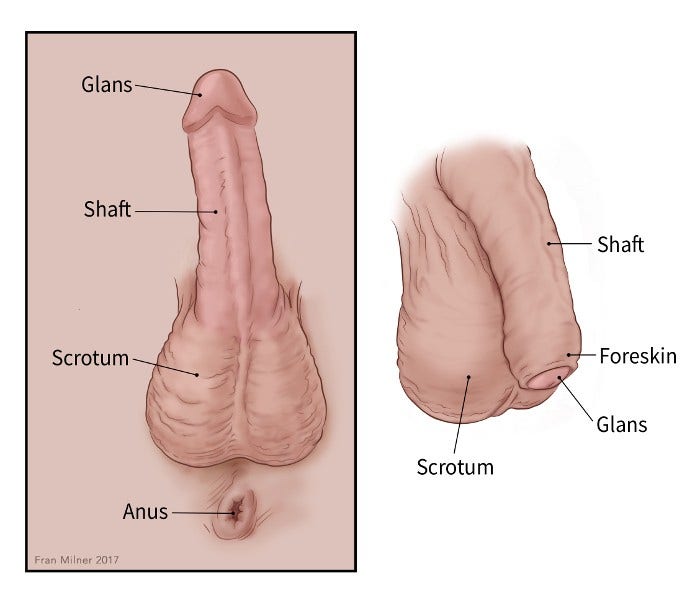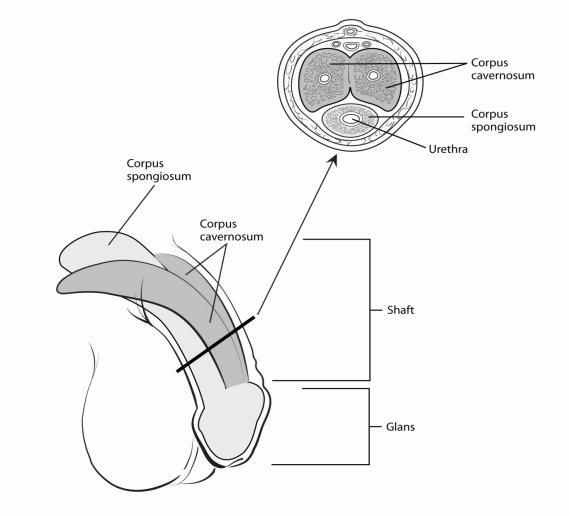What Is Penile Cancer?
Penile cancer starts in or on the penis. Cancer starts when cells begin to grow out of control. Cells in nearly any part of the body can become cancer, and can spread to other parts of the body. To learn more about how cancers start and spread, see What Is Cancer?
About the penis
The penis is the external male sex organ. It's also part of the urinary system. It's made up of many types of body tissues, including skin, nerves, smooth muscle, and blood vessels.

The main part of the penis is known as the shaft, and the head of the penis is called the glans. At birth, the glans is covered by a piece of skin called the foreskin, or prepuce. The foreskin is often removed in infant boys in an operation called a circumcision.
Inside the penis are 3 chambers that contain a soft, spongy network of blood vessels. Two of these cylinder-shaped chambers, known as the corpora cavernosa, are on either side of the upper part of the penis. The third chamber is below them and is known as the corpus spongiosum. This chamber widens at its end to form the glans. The corpus spongiosum surrounds the urethra, a thin tube that starts at the bladder and runs through the penis. Urine and semen travel through the urethra and leave the body through an opening in the glans of the penis, called the meatus.

To get an erection, nerves signal a man's body to store blood in the vessels inside the corpora cavernosa. As blood fills the chambers, the spongy tissue expands and the penis stiffens and gets longer. During ejaculation, semen (which contains sperm cells and fluids) flows through the urethra and out of the body through the meatus. After ejaculation, the blood flows back into the body, and the penis becomes soft again.
Benign conditions of the penis
Sometimes, growths can develop on the penis that are abnormal but are not cancers. (They are benign.) These lesions often look like warts or irritated patches of skin. Like penile cancer, they're most often found on the glans or on the foreskin, but they can also occur along the shaft of the penis.
Condylomas (genital warts)
These growths tend to look like tiny cauliflowers. Some are so small that they can only be seen with a magnifying lens. Others may be as large as an inch or more across. Condylomas are caused by infection with certain types of human papillomavirus (HPV).
Bowenoid papulosis
This condition is also linked to infection with HPV and tends to occur in younger, sexually active men. It's seen as small, red or brown spots or patches on the shaft of the penis. These may look like genital warts, but when looked at under a microscope, dysplastic (abnormal) cells are seen in the surface layer of the penile skin.
Bowenoid papulosis can also be mistaken for an early-stage cancer called carcinoma in situ (CIS), also known as Bowen disease (described below). Usually bowenoid papulosis doesn’t cause any problems, and it can even go away on its own after a few months. But if it doesn’t go away and isn't treated, in rare cases it can progress to Bowen disease.
Cancers of the penis
Each type of tissue in the penis contains several types of cells. Different types of penile cancer can start from these cells. The differences are important because they determine the seriousness of the cancer and the type of treatment needed.
Almost all penile cancers start in skin cells of the penis.
Squamous cell carcinoma
About 95% of penile cancers start in flat skin cells called squamous cells. Squamous cell carcinoma (also known as squamous cell cancer) can start anywhere on the penis. Most of these cancers start on the foreskin (in men who have not been circumcised) or on the glans. These tumors tend to grow slowly. If they're found at an early stage, they can usually be cured.
Verrucous carcinoma: A verrucous carcinoma growing on the penis is also known as Buschke-Lowenstein tumor.This is an uncommon form of squamous cell cancer that can start in the skin in many areas. This cancer looks a lot like a large genital wart. Verrucous carcinomas tend to grow slowly but can sometimes get very large. They can grow deep into nearby tissue, but they rarely spread to other parts of the body.
Carcinoma in situ (CIS): This is the earliest stage of squamous cell cancer of the penis. In this stage, the cancer cells are found only in the top layers of skin. They have not yet grown into the deeper tissues. Depending on where the CIS is on the penis, doctors may use other names for the disease.
- CIS of the glans is sometimes called erythroplasia of Queyrat.
- CIS on the shaft of the penis (or other parts of the genitals) is called Bowen disease.
Melanoma
Melanoma is a type of skin cancer that starts in melanocytes, the cells that make the brownish color in the skin that helps protect it from the sun. These cancers tend to grow and spread quickly. They're more dangerous than the more common basal and squamous cell types of skin cancer. Melanomas are most often found in sun-exposed skin, but rarely they occur in other places like the penis. Only a very small portion of penile cancers are melanomas. For more information about melanoma and its treatment, see Melanoma Skin Cancer.
Basal cell carcinoma
Basal cell carcinoma (also known as basal cell cancer) is another type of skin cancer that can develop on the penis. It makes up only a small portion of penile cancers. This type of cancer is slow-growing and rarely spreads to other parts of the body.
Adenocarcinoma (Paget disease of the penis)
This very rare type of penile cancer can develop from sweat glands in the skin of the penis. It can be very hard to tell apart from carcinoma in situ (CIS) of the penis.
Sarcoma
A small number of penile cancers are sarcomas. These cancers develop from blood vessels, smooth muscle, or other connective tissue cells of the penis. For more about this type of cancer, see Soft Tissue Sarcoma.
- Written by
- References

The American Cancer Society medical and editorial content team
Our team is made up of doctors and oncology certified nurses with deep knowledge of cancer care as well as editors and translators with extensive experience in medical writing.
American Society of Clinical Oncology. Penile Cancer: Introduction. 8/2017. Accessed at www.cancer.net/cancer-types/penile-cancer/introduction on May 24, 2018.
Cancer Research UK. About penile cancer. 10 Mar 2016. Accessed at www.cancerresearchuk.org/about-cancer/penile-cancer on May 24, 2018.
Last Revised: June 25, 2018
American Cancer Society medical information is copyrighted material. For reprint requests, please see our Content Usage Policy.
American Cancer Society Emails
Sign up to stay up-to-date with news, valuable information, and ways to get involved with the American Cancer Society.


